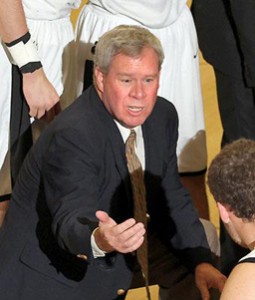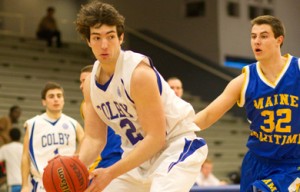Contributor Adam Lamont has ranked the NESCAC teams from Amherst (1) to Bates (11).
1) Amherst (8-1): Two comfortable wins for the Lord Jeffs over the weekend is what should be expected for a veteran team. The potential loss of sophomore center Ben Pollack to injury could leave the front court even thinner than before. If Pollack’s injury is serious then freshman David George will start and see a heavy does of minutes the rest of the season. Pollack is Amherst’s most effective interior scorer and though George has a lot of potential, his offensive game is raw. If Pollack can’t return then the perimeter scorers for the Jeffs will have even more pressure on them to carry the load. Their final game against Middlebury will be difficult and features great matchups on the perimeter.
2) Williams (7-1): They started three freshman this weekend and won both games going away. You probably need no reminder, but it can’t hurt to emphasize: the future is bright for the Ephs. They have the second seed locked up and could end up being number one if Amherst falls. We don’t have word on whether Taylor Epley or Hayden Rooke-Ley will return, but Williams will need them to make a run deep in the NCAA Tournament. Freshman Duncan Robinson is almost assured a First-Team All-NESCAC spot and if he closes strong he could get Player of the Year honors as well. And he has three more years to terrorize the NESCAC …
3) Middlebury (5-3): The Panthers had the best weekend in the conference beating Colby and Bowdoin. Senior Guard Joey Kizel is playing like the All-American he is, and Dylan Sinnickson is a great second option on offense. They have a tough weekend ahead traveling to Trinity and Amherst. Trinity is a physical team that Middlebury can’t overlook before playing Amherst. If Middlebury had hung on to beat Williams they would start to be in the conversation for an at-large bid to the NCAAs, but at this point they probably need to win the NESCAC Tournament — a tall task, but far from impossible.
4) Bowdoin (5-3): First, this is based heavily on how teams have done recently (essentially in conference play) so ranking Bowdoin below Middlebury here is not an evaluation of their overall seasons or NCAA tournament worthiness. The way Bowdoin lost to Middlebury was obviously disheartening, but the Polar Bears did not deserve to win the game. They missed a lot of easy layups and foul shots. The trend of losing narrow games to their best opponents is disconcerting, but Bowdoin is learning from these games. They face a rivalry game against Bates who they barely beat earlier in the year. The Polar Bears should jump all over the Bobcats the second time around given Bates’ struggles in conference play.
5) Trinity (5-4): The overtime loss to Colby two weeks ago looked like it killed any hope the Bantams would have of hosting a NESCAC tournament game, but a win against Middlebury this weekend will ensure the Bantams of just that. Sophomore forward Shay Ajayi is really starting to come on, giving Trinity a little more offensive punch. Ajayi had 18 points and 10 rebounds in the Bantams’ 98-point performance against Conn. College — easily their high-water scoring mark this season. If they can come close to that type of play again and have the stifling defense they have shown all year they will be a really tough out in the NESCAC tournament.
6) Hamilton (4-4): The Continentals have roared into relevance (relatively speaking) in the second half of the NESCAC schedule. They can get a home game in the first round of the NESCAC tournament if they win their last two, Middlebury beats Trinity and loses to Amherst. Not likely, but certainly not impossible. Matt Hart is only a sophomore, and next year he will be the premier guard in the conference. He is already the best pure scoring guard, but needs to do a better job creating for his teammates.
7) Colby (3-5): It was a disappointing performance last Friday against Middlebury as the Panthers came out fired up and put Colby in the rearview mirror early on. They can still get to .500 in conference if they win their final two. Point Guard Luke Westman doesn’t shoot very often, but he is unbelievably efficient. Despite not making a three all season, he is shooting almost 65 percent from the floor so far this season. Along with Chris Hudnut and Patrick Stewart, Westman will be the key for Colby to make the leap next year into conference title contention.
8) Wesleyan (3-5): This isn’t to disparage Wesleyan, but there is definitely a drop off after Colby to the Cardinals. Maybe I’m discounting Wesleyan, but to me the most surprising conference game this year was that Middlebury needed a few last second shots and double overtime to escape Middletown with the victory. Wesleyan has nice pieces including freshman Harry Rafferty, who leads the team in scoring. He has to become a more efficient scorer and turn the ball over less, but with the graduation of Kizel and Toomey, he will become one of the standard bearers of NESCAC point-guard play.
9) Tufts (2-6): This is not the season that people in Medford signed up for. I don’t know if it’s the bus ride to Hamilton or what, but the Continentals claimed the Jumbos as the latest to fall victim in Clinton. This was despite Matt Hart only scoring 11 points. It seems like whenever a couple of players have good games, it means that everyone else will struggle. They were not at all competitive in their loss to Williams. Still, if they win Friday against Colby, Tufts controls its NESCAC-tournament destiny.
10) Conn College (2-6): Not too much new to talk about with Conn. The Camels have leaned heavily on seniors Matt Vadas and Mason Lopez this year. Their graduation will leave a dearth of scoring and leadership. Hey, recruits: Immediate playing time available in New London! In all seriousness Vadas needs only 19 points to become the Camels’ all-time leading scorer. He has been a prolific scorer and if he can carry his team to a pair of wins, Conn. College has an outside shot at a tournament berth.
11) Bates (1-7): Anyone who predicted Bates to finish 1-7 after beating Middlebury in the coference-opener is a soothsayer. This team played Amherst very tight for 30 minutes, but just got run out of the gym against Hamilton. Graham Safford’s play has dropped off considerably from the beginning of the season and the Delpeche brothers have not developed over the season. It will be interesting to see how Bates responds playing two rivals at home to close the season.

